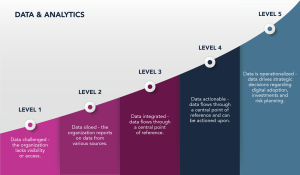I’ve been thinking about the Marketing Maturity Model blog that I wrote a year ago and reflecting on the faux simplicity of it all. If you haven’t read it, I suggest doing so as this blog will make much more sense with that context. While it’s a useful framework for evaluating the broader landscape of an organization’s marketing maturity, it’s also very high-level. It’s like saying “here is a map, and you can see that it is made up of landscape features, roads, mile markers, territory lines, etc.,” but if you’re trying to drive from Phoenix to Portland, you might need a little more information. Could you follow the map I gave you? Yes, technically, but you’d be winging a lot of the details along the way.
To that end, this blog will dive deeper into the Data & Analytics Marketing Maturity Model, and specifically outline some of the key questions, strategic decisions, tactical moves, and common challenges and pitfalls that are required to move your organization from one level to the next.

Organizations That Want to Move From Being Data Challenged (Level 1) To Data Siloed (Level 2) Need To Prioritize Data Over Gut Instinct

A level one organization on the Marketing Maturity Model scale is defined by opportunism, which lacks structure, strategy, or process. These organizations often make decisions based on trends, gut instinct, or anecdotal evidence rather than data. The priority for an organization of this type is to agree that there is an opportunity to be more data-driven and invest resources into identifying and acquiring the data to do so.
Key Questions:
- What business decisions are you making based on instinct, guess, anecdotal evidence or because it’s the trendy thing to do?
- What business questions can you not answer because of lack of data today?
- What would you do differently if you could answer those business questions with data?
- How important is it to your organization to be data-driven and why?
- What factors have led to gaps in data visibility or access in the past?
Strategic Decisions:
- Prioritize data at the leadership level. Culturally this shift needs to be driven from the top down.
- Determine what data is critical and what data is nice to have. This is a critical step and cannot be delegated to execution teams because it requires making tradeoffs, taking a long-term perspective, accepting a certain level of uncertainty, and ensuring organizational alignment.
- Not sure where to start? Here are six common areas that data can improve business decision making: 1. Market research and customer insights, 2. Product development & innovation, 3. Pricing and revenue optimization, 4. Operational efficiency, 5. Marketing and advertising effectiveness, 6. Customer relationship management
Tactical Moves:
- Identify stakeholders who are/or will be responsible for managing and accessing data within your organization
- Scope and hire for the initial project to set baseline data strategy
- Implement tracking
- Define reporting requirements – Remember the 3 F’s: function, format, and frequency
Common Challenges & Pitfalls:
- Implementation gaps – Lack of focus or inability to execute due to misaligned or misappropriated resources, capabilities, process and culture with strategic goals
- Scope creep – trying to accomplish too much too quickly, changing direction
An Organization Moves from Data Siloed (Level 2) To Data Integrated (Level 3) By First Determining Which Areas of The Business Are Most Critical to Integrate And Why

A level two organization, as it relates to data strategy, is likely to look at data within an isolated context, such as channel performance or stand-alone outcomes. Think of these as standard KPIs that a single delivery team might focus on.
For example, social media teams may look at metrics for engagement and reach but fail to look at traffic driven, sales, customer loyalty or customer demographics. A marketing automation specialist may report on and prioritize improving deliverability and open and click through rates, but fail to look at sales revenue or acquisition vs. retention data. Even a skilled media team may focus exclusively on ROAS and miss CLV or even seasonality trends if not given the opportunity to expand their definition of what metrics they are responsible for directly or indirectly.
None of these KPIs are wrong to focus on, but they are often disconnected from the downstream business outcomes for one reason or another. In most cases, this is because they lack data visibility to report outside of the platforms and channels that they are directly responsible for, or they are not empowered (or expected) to do so.
Key Questions:
- What are the individual data siloes within the organization?
- Who are the key stakeholders who access and manage those data centers?
- What are the barriers to integration across teams? Are they technical (this tool doesn’t connect to that tool), process-oriented (all data is gate-kept by IT), or strategic in nature (failure to ask the right questions)?
- How do resources get prioritized across functions of the marketing team?
- Do we have a good understanding of our personas and customer journey?
Strategic Decisions:
- Determine which areas of the business are most critical to integrate and why
- Decide what processes need to change and assign a champion
- Decide what technical roadblocks are in place and assign a champion
- Decide what strategic barriers are in place and assign a champion
Notice that each of these strategic decisions ends with “and assign a champion”. This is highlighted in the Common Challenges & Pitfalls as well, but bears repeating. If these projects do not have clear ownership internally, and that person is empowered to see it succeed, then it will fail.
Tactical Moves:
- Audit the Tech Stack for tech debt, redundancies, siloes and inconsistencies
- Develop a solutions architecture for the MarTech/TechStack of the organization. This is best done as current state and future state
- Build a technical roadmap to move from current state to future state including eliminating redundant systems, unifying data across platforms, and solving for tech debt
- Assign appropriate resources to implementing the technical roadmap and acquiring tools/technologies as appropriate to the strategy. This may involve hiring decisions to bring on in-house expertise or third-party agency partners
Common Challenges & Pitfalls:
- Assigning areas of the project to existing resources that lack the skills or experience to implement properly
- Assuming that acquiring tools/technology will provide a quick solution
- Failing to educate teams and build buy-in along the way
An Organization Moves from Data Integrated (Level 3) To Data Actionable (Level 4) By Unifying Data at The Customer Level
![]()
Moving to Data Actionable on the Marketing Maturity curve is one of the only points in this evolution where a particular tool is pretty much required: a Customer Data Platform (CDP). Many, if not all, of the use cases to action on your data will need a CDP to orchestrate in real or near-real time.
A Customer Data Platform is software that centralizes customer data from various business sources and can connect that data to downstream platforms such as digital media, personalization, A/B testing, lifecycle marketing and more. CDPs differ from other data management systems, such as Customer Relationship Management (CRM) systems, in that they are designed to focus solely on collecting and managing customer data, with a strong emphasis on creating a unified and real-time customer profile.
There are many CDPs on the market with various pros and cons, so it’s important to do your due diligence when selecting a platform and partner agency to help with implementation.
Level 4, or the Data Actionable stage is also where things can start to get really fun for strategists because it unlocks the ability to ask and answer much more sophisticated questions. At this stage, advanced data visualization, data science and modeling begin to form and forecasting abilities become possible. Personalization across the customer journey is enabled and an enhanced testing plan can be executed.
Key Questions:
- Are we ready for a Customer Data Platform?
- What are our crawl use cases of actioning on our data?
- What is the estimated Net Present Value (NPV) of acquiring a Customer Data Platform over 12-24 months?
- Is our data in an appropriate state for CDP ingestion? For example, how do you handle Personally Identifiable Information (PII) today?
Strategic Decisions:
- Develop a Strategic Use Case roadmap that takes the implementation from Crawl to Run over 12-18 months
Tactical Moves:
- Select a CDP vendor
- Hire a partner agency to help with strategy and implementation
- Assign internal resources to manage and assist with the project as necessary
Common Challenges & Pitfalls:
- Thinking that acquiring a CDP alone is the answer
- Collecting data without a strategy
- Failing to educate teams outside of marketing on how the CDP works, why it was acquired and how it can help them with their individual business domain
- Not considering the existing MarTech ecosystem
- Not defining the CDPs role within the full MarTech ecosystem
- Unrealistic expectations
- Not having a CDP champion
Building A Data Operationalized Team or Organization Takes Discipline and Leadership

Reaching this level of marketing maturity, especially with data and analytics, is extremely difficult because it requires discipline and advocacy for less flashy projects. Data operationalization relies on process, documentation, and maintaining a data center of excellence and the team to power it. It likely involves heavy use of automation, strong data governance plans and a well-oiled MarTech machine.
The Evolution from Data-Challenged to The Pinnacle Of Data Operationalization Is A Substantial Endeavor
As we delve into the intricacies of the Marketing Maturity Model and explore the journey from one level to the next, the path is marked by strategic decisions, tactical maneuvers, and overcoming common challenges. Each phase brings its own set of questions, considerations, and actions that organizations must navigate to elevate their marketing strategies.
Throughout the journey, it’s evident that every stage is a crucial steppingstone, building upon the lessons of the previous level. As organizations ascend, they unlock new capabilities, broaden their insights, and enhance their effectiveness.
